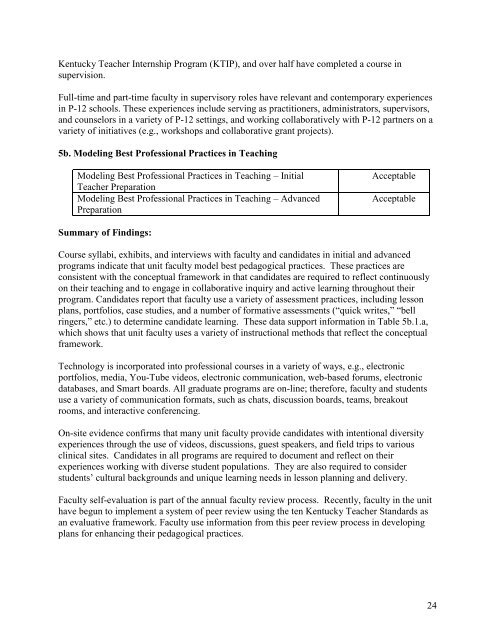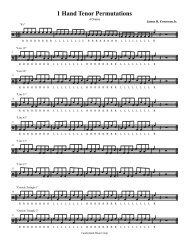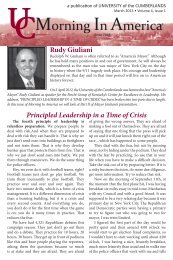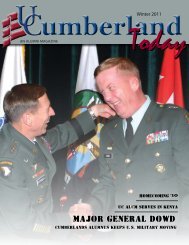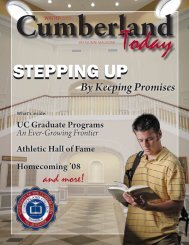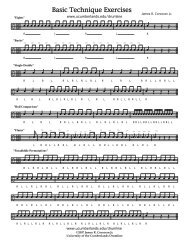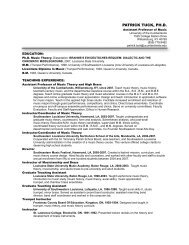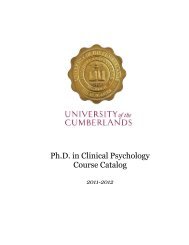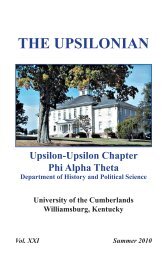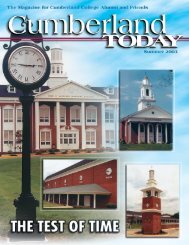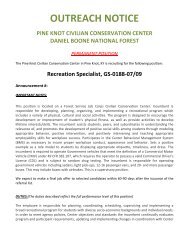EPSB - University of the Cumberlands
EPSB - University of the Cumberlands
EPSB - University of the Cumberlands
You also want an ePaper? Increase the reach of your titles
YUMPU automatically turns print PDFs into web optimized ePapers that Google loves.
Kentucky Teacher Internship Program (KTIP), and over half have completed a course insupervision.Full-time and part-time faculty in supervisory roles have relevant and contemporary experiencesin P-12 schools. These experiences include serving as practitioners, administrators, supervisors,and counselors in a variety <strong>of</strong> P-12 settings, and working collaboratively with P-12 partners on avariety <strong>of</strong> initiatives (e.g., workshops and collaborative grant projects).5b. Modeling Best Pr<strong>of</strong>essional Practices in TeachingModeling Best Pr<strong>of</strong>essional Practices in Teaching – InitialTeacher PreparationModeling Best Pr<strong>of</strong>essional Practices in Teaching – AdvancedPreparationAcceptableAcceptableSummary <strong>of</strong> Findings:Course syllabi, exhibits, and interviews with faculty and candidates in initial and advancedprograms indicate that unit faculty model best pedagogical practices. These practices areconsistent with <strong>the</strong> conceptual framework in that candidates are required to reflect continuouslyon <strong>the</strong>ir teaching and to engage in collaborative inquiry and active learning throughout <strong>the</strong>irprogram. Candidates report that faculty use a variety <strong>of</strong> assessment practices, including lessonplans, portfolios, case studies, and a number <strong>of</strong> formative assessments (“quick writes,” “bellringers,” etc.) to determine candidate learning. These data support information in Table 5b.1.a,which shows that unit faculty uses a variety <strong>of</strong> instructional methods that reflect <strong>the</strong> conceptualframework.Technology is incorporated into pr<strong>of</strong>essional courses in a variety <strong>of</strong> ways, e.g., electronicportfolios, media, You-Tube videos, electronic communication, web-based forums, electronicdatabases, and Smart boards. All graduate programs are on-line; <strong>the</strong>refore, faculty and studentsuse a variety <strong>of</strong> communication formats, such as chats, discussion boards, teams, breakoutrooms, and interactive conferencing.On-site evidence confirms that many unit faculty provide candidates with intentional diversityexperiences through <strong>the</strong> use <strong>of</strong> videos, discussions, guest speakers, and field trips to variousclinical sites. Candidates in all programs are required to document and reflect on <strong>the</strong>irexperiences working with diverse student populations. They are also required to considerstudents’ cultural backgrounds and unique learning needs in lesson planning and delivery.Faculty self-evaluation is part <strong>of</strong> <strong>the</strong> annual faculty review process. Recently, faculty in <strong>the</strong> unithave begun to implement a system <strong>of</strong> peer review using <strong>the</strong> ten Kentucky Teacher Standards asan evaluative framework. Faculty use information from this peer review process in developingplans for enhancing <strong>the</strong>ir pedagogical practices.24


